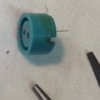Oops. I think that there is a bit of a mis-undersatnding of how the braking system of on the ST1300 works. Let me try to explain. The same applies to all models, with and without ABS.
The rear pedal master cylinder has two brake lines attached to it - two Banjo unions on one bolt. So both lines are fed from the same outlet port when the pedal is pressed. One line goes to the rear, one goes to the front. Further details are in the explanations below.
The middle rear caliper is operated only by the Secondary Master Cylinder (SMC) on the front fork.
The middle piston in the rear caliper is operated only by the foot pedal. The line heading to the rear from the rear master cylinder.
The movement of the SMC operates only the two outer pistons in the rear caliper - and the pressure applied is controlled (and reduced) as the pressure from the SMC increases to prevent the rear wheel from locking as the stopping force reduces the weight on the back wheel. This is managed by the proportional control valve which is mounted under the tank near your right knee.
Riding smoothly, or using mainly the rear brake, means it never gets exercised.
The footbrake also acts on both front caliper centre pistons. So the SMC will be operated every time you apply the rear brake.
The front right centre piston is subject to a pressure delay - which means that it isn't activated unless the pressure from the pedal is sufficient to overcome a strong spring in the delay valve on the front right fork leg. This is to prevent the front from diving when using the brake pedal during slow speed manoeuvres.
The centre piston in the left front caliper is activated immediately the rear pedal is pressed. The left hand caliper rocks forward and activates the SMC, which in turn activates the outer pistons on the rear caliper.
So pressing the brake pedal will always affect the front left caliper (centre piston) and all three pistons on the rear caliper - the centre one directly, the outer ones as a result of the SMC being activated by the front centre piston applying the brake on the left front caliper. Press harder and the front right centre piston is also applied. You may feel a very slight dip in the pedal when this happens.
If this is case it is worth grabbing the front brake occasionally to exercise the SMC / piston, they are operated only by the rear pedal.
The SMC will always be operated whichever pedal/lever you use. But the movement is very tiny - only about 1-2 mm. I believe it is better to exercise the SMC during the regular bleeding schedule when the rear outer bleed valve or the PCV bleed valve is open. This allows it to move the full stroke which I believe helps to flush out the old grotty fluid and prevent the build up of crystals and gunge.
My local Most (UK safety test) report getting several bikes a year with the centre rear piston not touching the pad.
Pads have effectively worn down and moved away from static piston. Many can be cured by a hard application of the front brake on his rolling road. The rest need a caliper strip.
"Most" ? Is that MOT ? If you
never use the rear pedal, then none of the centre pistons will ever move as the pads wear down. The front brake lever doesn't act on any of the 3 centre pistons, directly or indirectly.
Nb - To complete the picture, when the bike is in the garage and is not moving, the SMC will not operate. It needs the spinning brake disc to rock the left hand front caliper bracket forward. But you can test its operation by hand.
But in this case, the rear pedal will operate all three pistons in the rear caliper !
The centre piston is operated directly by one fluid line.
The outer pistons are operated by fluid in the line to the front centre pistons. The same line feeds the SMC, and fluid will flow past the seal, back up the fork leg, through the Proportional Control Valve and on to the outer pistons.
'Flowing past the seal' sounds odd, but that is what happens. All 3 master cylinders have a cupped primary seal, which allows them to yield as a result of pressure from behind. Cupped seals only seal in one direction. This is just like the seal in a bicycle pump which allows air to pass on the upstroke to refill the tube, but prevents air passing on the downstroke, forcing the air into the tyre.
So when the SMC isn't activated, the fluid flows straight through the SMC.

















